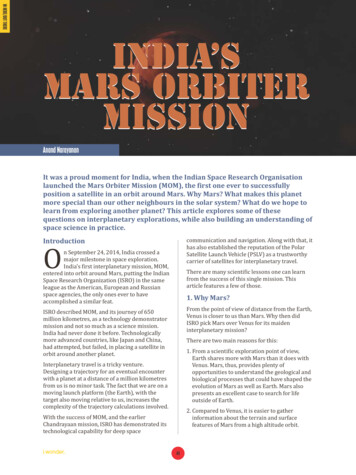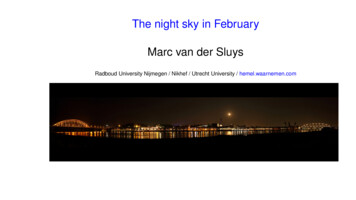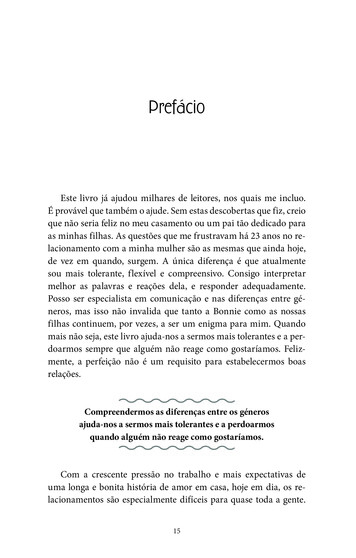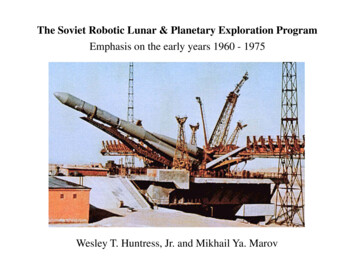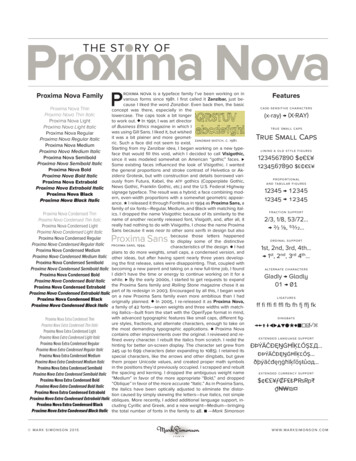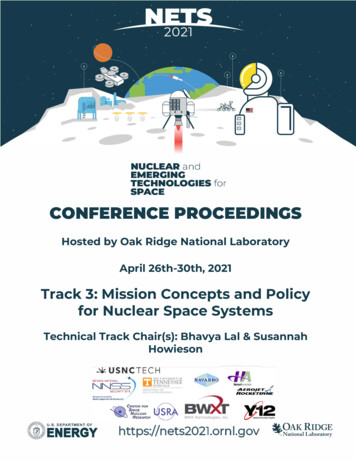
Transcription
From Venus to Mars?
Neueste MilitärgeschichteAnalysen und StudienBegründet vomMilitärgeschichtlichen ForschungsamtHerausgegeben vomZentrum für Militärgeschichte undSozialwissenschaften der BundeswehrBand 3
From Venus to Mars?Provincial Reconstruction Teams andthe European Military Experience inAfghanistan, 2001-2014On behalf of Bundeswehr Centre ofMilitary History and Social Sciencesedited byBernhard Chiariin collaboration with Thijs Brocades Zaalberg, Nicola Labancaand Ben Schoenmaker
Umschlagabbildung:Key leader engagement, conducted by Dutch ISAF troops from PRT Pul-eKhumri, Baghlan Province, 11 August 2005 (NIMH, collection PRT Baghlan).Die Deutsche Nationalbibliothek verzeichnet diese Publikation in der Deutschen ę Dzȱ ȱ ę ȱ ȱ ȱ ȱ ȱ û ȱǯ ǯ ȱ Ġ ǯ ȱ Ě 2014 Rombach Verlag KG, Freiburg i.Br./Berlin/Wien ȱ ȱ đ ȱ ȱ ȱ ȱ ȱ ûĵ ǯȱ ȱ ȱ đ ȱ ȱ ȱ ȱ ĵ ȱ ȱ ȱ ȱ ȱ ȱ § ȱ ȱ Ġ ǯȱ ȱ ȱ ȱ û ȱ § ǰȱt ĵ ǰȱ ę ȱ ȱ ȱ ȱund Bearbeitung in elektronischen Systemen.Gedruckt auf säurefreiem, alterungsbeständigem Papier (chlorfrei gebleicht).Redaktion: ZMSBw, Potsdam, SchriftleitungKoordination, Bildrechte: Michael ThomaeLektorat: Nancy Pearson Mackie, Calgary/Kanada ĵDZȱ ȱ ǰȱ ȱ ę DZȱ ȱ ǰȱ ȱ DZȱ ȱ ĵBildteil: Maurice WoynoskiCover: Maurice Woynoski, Carola KlinkeGesamtherstellung: Rombach Druck- und Verlagshaus GmbH & Co. KG,Freiburg i.Br.Printed in GermanyISBN 978-3-7930-9771-6
Contents911PrefaceBernhard ChiariSearching for the right audience: The military’s ISAF experiencePart I: Evolution, structures, performance31Peter DreistProvincial Reconstruction Teams as elements of OEF and ISAF:The development of an operational tool to stabilize Afghanistan51Philipp Rotmann and Lauren HarrisonCritical voices: Did the PRTs perform well in Afghanistan?65Jan KoehlerThe Afghan perspective on ISAF:Changes and trends in northeast Afghanistan87 ȱ Ĵ ȱThe unknown unknowns:The use of knowledge in Western intervention politics103Bernd LemkeHistorical foundations of Counterinsurgency as a Western»strategy« for AfghanistanPart II: Case studies – The »European« Regional CommandsNorth and West123Guy HarrisonThe time before Helmand:British engagement in northern Afghanistan until 2006135Bernhard ChiariA New Model Army: The Bundeswehr in Kunduz, 2003-2012157Christian Stachelbeck»Serving at a remote outpost.« The Bundeswehr at Fayzabad, 2004-2012
6Contents177Erwin van LooDutch Forces in Pul-e Khumri, 2004-2006: ȱ ȱ ȱ ȱ ȱ ȱ 195Péter WagnerUnable to adapt: The Hungarian PRT in Baghlan209Jan Willem Honig and Ilmari KäihköThe likely lads: The Joint Swedish-Finnish PRT in Mazar-e Sharif221Lene Ekhaugen and Ida Maria OmaNorwegians in Maymanah: Between on-the-ground developments anddomestic politics233 ȱ ³Í Turkey in Sheberghan: Special solutions due to special relations?245Gastone BrecciaHearts, minds and guts: Running the Italian PRT in Herat.A civilian perspective257 ȱ ȱ ȱ ȱ ȱSpain’s contribution in Herat and the Badghis PRT267James S. CorumServing NATO. The Lithuanian engagement in Ghor Province281Kenneth M. HollandFighting the real war? US PRTs in Farah and KhostPart III: Experiences and perceptions –The German and Italian Armed Forces after Afghanistan301Klaus NaumannShaping a new soldier? Military professionalism in complex missions317 ȱ ě Holidays at »Kunduz Spa«? Experiences of German soldiers inAfghanistan333Giuseppe Caforio ȱ ȱ ȱ ȱ DZȱ ȱ Ȃȱ ȱ ȱ ȱ ȱenvironment
Contents347Fatima FarinaA female perspective from the front? Italian servicewomenin Afghanistan361Valentina Albini and Nicola LabancaMilitary deaths as newspaper stories: Italian losses in Afghanistanand the mass media377Volker HartmannMedical Service in Afghanistan: The Fayzabad example.Strategies from mass casualties to individual medical care393Ralf Vollmuth ȱ ȱ ȱ ȱ ȱ ȱ ȱ ȱ Ě DZȱMedical and ethical problemsAnnex405429439445469475PicturesChronicle of political and military events in Afghanistanfrom 2001 to 2013AbbreviationsBibliographyIndexList of contributors7
PrefaceIn 2014, the ISAF mission in Afghanistan will come to end after more thantwelve years of international military presence in the country. This is an ex ȱ ȱ ȱ ȱ ȱ ę ȱ ȱ ȱ ȱ Ȃ ȱ ȱ ȱ ȱ ȱProvincial Reconstruction Teams (PRTs). The PRTs became a synonym for the Ĵ ȱ ȱ ȱ ȱ ȱ ȱ ȱ Ĵ ȱ ȱŗŗȱ ȱŘŖŖŗǰȱthe US-supported victory of the Northern Alliance and the breakdown of theTaliban Regime. They were a central tool supporting the government of a new ǰȱ ȱ ę ȱ ȱ ȱ ȱ ȱ ȱ Petersberg near Bonn,starting on 27 November 2001. Originally established as part of the US-led anti-terror Operation Enduring Freedom, the PRTs were handed over successivelyto ISAF control and within several years covered almost all Afghan Provinces.Organized and run as a national responsibility, every PRT command left its ȱ ȱ ȱ ȱ ȱ ȱ ȱ ȱ ě ȱ ȱ ȱ ȱhow to support the Afghan administration in building up a functioning centralstate. What ISAF and its PRTs, national ministries, interdepartmental entities,Governmental and Non-Governmental organizations achieved in Afghanistan ishighly respectable. In 2014, however, several questions remain with regard to thestability of Afghanistan’s future. This collection of essays, therefore, concentrateson the European contributions to ISAF in the Regional Commands North and ǰȱ ȱ ȱ ě ȱ ȱ ȱ ȱ ȱ ȱ ȱ ȱ ȱ ȱabroad. Thus, it will hopefully contribute to an discourse on the future role ofthe international community in cases comparable to the mission in Afghanistan.Whereas this volume mainly deals with the role of the Provincial ReconstructionTeams from a more military point of view, further case studies, which will soon ǰȱ ȱ ¡ ȱ ȱ Ě ȱ ȱ ȱ ȱ ȱ ȱ ȱ ȱ ȱby also taking into account domestic politics, social, economic, and culturaldevelopments.Historians, political scientists, sociologists and representatives of other academic disciplines contribute to this volume with their expertise, their indi ȱ ȱ ȱ ȱ ě ȱ ȱ ȱ ǯȱ ȱ ȱ ǯȱ ȱ ȱǻ Ǽȱ ȱ ȱ ȱ ȱ ȱ ȱ ȱ ing an international conference in the Villa Vigoni, supported by the DeutscheForschungsgemeinschaft (»On the Road towards European Armed Forces?Changes of National Security Cultures between Homeland Defence and Missionsabroad since 1991«, April 2012). He brought and held the team together, navigat ȱ ȱ ȱ ȱ ȱ ȱ ȱ ȱ ȱ ȱ ȱ ě ȱ ȱ ȱ ȱ ǰȱ ȱ Ĵ ȱ ȱ ȱ ȱ ȱ ȱ ǰȱinto a consistent book. Prof. Dr. Nicola Labanca (Università degli Studi di Siena), ǯȱ ȱ ǯȱ ȱ ȱ ǻ ȱ ȱ ȱ ȱ ǰȱNIMH) and Prof. Dr. Ben Schoenmaker (NIMH/Leiden University) have sup ȱ ȱ ȱ ȱ ȱ ¡ ȱ ȱ ȱ ę ȱ ǯȱ ȱ ȱthem for opening doors for the ZMSBw which would have stayed closed proba ȱ ȱ ȱ ȱ ȱ ȱ Ĝ ȱ ȱ ȱ ȱ ȱ ȱ ǯ
10PrefaceMichael Thomae coordinated the editorial work within the ZMSBw editor ȱ ȱ ȱ ȱ ȱ ȱ ǯȱ ȱ û ȱ ǻ ȱ Ĝ ȱof Languages) skillfully coordinated the necessary translations. Without theknowledge and expertise of Nancy Pearson Mackie (Center for Military andStrategic Studies, CMSS, University of Calgary), this book would not have been ǯȱ ȱ ȱ ȱ ȱ ȱ ȱ ȱ ȱ ȱ ǰȱ ȱ ȱ ȱ ȱ ȱ ȱ ȱ ȱ ȱ ȱ ǯȱ ȱown special thanks to Dr. Torang Sinaga and the Rombach Publishing House,Freiburg, who once more again took the risk to publish an English title in theNeueste Militärgeschichte series. First and foremost, however, I must thank all authors for their contributions and for entrusting the ZMSBw with the edition.Dr. Hans-Hubertus MackColonel and Commander ZMSBw
Bernhard ChiariSearching for the right audience:The military’s ISAF experienceThe International Security Assistance Force (ISAF) in Afghanistan started its mission in 2001. With a military presence of only 5,000 troops, its task was to assistthe Afghan Security Forces in providing security in Kabul. ISAF remained separate from the US-led anti-terror mission Operation Enduring Freedom (OEF). Insupport of the Bonn Process, however, ISAF included more and more OEF troopsand resources as the operation progressed. Until the summer of 2003, the mission was led by four individual nations, Great Britain, Turkey, Germany and theNetherlands, at which point NATO took over the headquarters in Kabul and themission. In October 2003, UN Resolution 1510 extended the ISAF area of responsibility beyond the borders of Kabul.In the dialogues of specialists, politicians and – to a far lesser extent – inthe perception of the European public, civil-military Provincial ReconstructionTeams (PRTs) have been the central ISAF tool to stabilize Afghanistan. ThesePRTs, originally established as part of OEF and based on experiences gained inIraq, covered a continuously growing number of provinces (28 installations inOctober 2011), and were each manned with up to several hundred military andcivilian personnel. Functioning as a kind of Western bridgehead, their ultimategoal was to enhance the popular legitimacy of the Afghan government by developing Afghan capacities to conduct reconstruction, and to support the provision of security and good governance. Designed as interdepartmental teams, ȱ ȱ ǰȱ ǰȱ ȱ ȱ ȱ ȱ ȱ ȱ tion with the Afghan government. This included the distribution of school andmedical supplies, construction work to improve the local infrastructure, as wellas police training, programs to support the Afghan law enforcement authorities ȱ ȱ ȱ ȱ ȱ ǯȱ ȱ ǰȱ ǰȱ ȱ ȱ ȱ ȱ ȱ ȱ ȱ ǰȱ ȱ ȱ ȱ ȱ ě ǰȱ ȱ ǰȱ ǰȱ ȱ ěǰȱ ǰȱ ȱ ȱ ȱ ȱ ȱprotection.Between 2002 and 2013, the PRTs in Afghanistan faced many challenges foronly limited results. After 2006, a deteriorating security situation in many parts of ȱ ȱ ȱ ȱ Ĵ ȱ ȱ ȱ ȱ ȱȮȱ ȱ ȱthe term »Taliban movement« – brought the purely military aspects of the mis ȱ ȱ ȱ ȱ ȱ ȱ Ĵ ǯȱ ȱ ȱ ȱ ȱ ȱLondon(2006), optimistic (neo)liberals announced that »failed states« in the »Third ȍȱ ȱ ȱ ȱ ȱ ȱ Dzȱ ȱ ȱ Ȭ ȱ ȱ ȱ ȱ ȱ ȱ ȱ ȱ ȱ ȱę ȱ ȱ mies. Afghanistan proved this an illusion.In the west and north, the escalation of violence and the intensity of militaryoperations reached their peak in 2010 with hot spots in Badghis, Faryab, Kunduz,
12Bernhard Chiariand Baghlan Provinces. In Europe and the US, the public became aware that the ȱ ȱ ȱ ȱ ȱ ȱ ě ǯȱ ȱ ȱ ȱ ȱ vested in the mission, it is evident that the civilian and military engagement didnot meet the expectations – neither those of the international community northose of most of the Afghans. Instead, the length of the intervention, the exorbitant costs, the loss of human life, the lack of legitimacy and very complex demands for leadership had to be explained to the US and European publics.This book focuses on the European military forces as part of the security andstabilization architecture in Afghanistan. It outlines how, in the tremendously Ĝ ȱ ȱ ȱ ȱ ǰȱ ȱ ǰȱ ȱ ȱ ȱ ȱ vilian instrument for reconstruction, got pulled into a military mission and, temporarily, into a war. The authors give various insights how »the« ISAF mission ȱ ȱ ȱ ě ȱ ȱ ȱ ȱ ȱ ǰȱ ȱ ǰȱor HQs, and how these levels interconnected. The case studies also show how,despite the existence of comprehensive, interdepartmental, and civil-militaryconceptions, ISAF and the PRTs were in fact driven by individual actors and ȱ ę ȱ ǰȱ ȱ ȱ ǰȱ ǰȱ ǰȱ ǰȱ ȱ ǯȱDesignating the PRTs as catalyzers of diverging national philosophies and understandings, we try to show how these installations worked on the diplomaticpolitical level, and as parts of national bureaucracies and inter-agency collabo ǯȱ ȱ ȱ ǰȱ ȱ ¡ ȱ ȱ ȱ ȱ ě ȱ ȱ ȱPRTs on the ground, including Afghan perceptions, and ask how commandersand soldiers experienced their missions from an individual perspective. Finally,we discuss the way in which the ISAF and the PRTs were connected with thetroop contributing countries and in what way the Afghan experience changed ȱ ȱ ȱ ȱ ȱ ȱ ȱ ȱ ȱ ȱ Ě ȱ ȱ ȱ ȱ ȱ ȱ ǯȱ Ĵ ǰȱ ȱ ȱ ȱ ȱ ȱ ě ȱ ȱ ȱ ȱ ȱ ȱ ȱ ȱ ȱ ȱ ȱ ȱ ȱ ě ȱ ȱ ǯVenus and Mars? The Afghanistan settingThe PRTs were designed for a more or less peaceful environment after the fall ofthe Taliban regime in 2001 when organizing elections, physical reconstruction andthe disarmament of militias seemed to be the main challenges in Afghanistan. Tostabilize a war-shaken country with the help of diplomats and civilian specialists ȱ ȱę ȱ ȱ ȱ ȱ Ȭ ȱ ȱ ȱ ȱ ǯȱIn Afghanistan, the PRT tool obviously enabled a nation to determine what wasneeded most in the country. The presence of PRTs would, the public expected,create a functioning, more stable society, willing and capable to resist extremist Ĵ ǯȱ ǰȱ ȱ ȱ ȱ ȱ ȱ ȱ ȱ ȱ ǰȱ ȱ ȱ ȱ ȱ ȱ ȱ ȱ ǯȱ ȱ ȱę ȱ ȱ ȱ ing ISAF from Kabul to other parts of Afghanistan, even small European NATOmembers literally competed to become part of the PRT initiative. In the US and,
Searching for the right audience13to a lesser extent, in Europe, the PRT system was seen as an opportunity to provenational capabilities and – sometimes in a quite naïve way – to transport cultural ȱ ȱ ȱ ȱ ȱȎ ȍȱ ȱ ě ȱ ȱ ǯ1European countries ran – with the exception of the US in Farah Province– all PRTs in the Regional Commands (RC) North and West. In this book, theEuropean engagement in Afghanistan is described in detail and the war led bythe US in the south and east, supported by the UK, Canada, and Australia, is notin the focus.2 The European perspective seems important and relevant insofar asthe Afghanistan mission was a new experience for most of the European troopcontributors and therefore had far greater implications on their military and political systems as in the US or UK.In Germany, for example, ISAF was discussed as »Trial by Fire for a wholeNation.«3 Italy, the Nordic troop contributors, Hungary, Lithuania or Spain alsobelonged to the group of nations characterized by Robert Kagan in 2002 as »coming from Venus and not from Mars«: In the post-historical paradise of Europe,Kagan argued at that time, these states counted on trans-, inter- and supranational cooperation to secure peace and wealth. In contrast, the US were convincedthat only military power would enable a nation to hold its ground. The militarystrength of the US, eventually, gave the Europeans the opportunity to stay ontheir comfortable Venus planet for many years after the Berlin Wall had comedown.4ISAF developed momentum at least to put the Venus-Mars-dichotomy to discussion. In the early years of the mission, the spreading PRT-net on the one handand OEF on the other seemed to perfectly represent these two diverging philosophies.5 ISAF PRTs in the north and west were explicitly designed to contribute to ȱ ȱ Ȭ ȱ ȱ ȱ ȱȎ ȍǰȱ ȱ ǯȱ ȱPRT concept was ground laying in broadening the scope of peace support and Ȭ ȱ ě ǯȱ ȱ ȱ ȱ ȱ ȱ ȱ ȱ ȱ ǰȱ ȱ ȱ ȱ ȱ ȱ ȱ ȱ ȱ Ĵ ȱ ȱ ȱ ȱof an insurgency described as »Taliban.« Moreover, the US sent enormous troopreinforcements, thus progressively militarizing the ISAF mission.6123456Mike ǯȱ ǰȱȎ ȱ Ȭ ȱ ě ȱ ȱ DZȱ ȱ ȱ ǰȍȱJournal of Military and Strategic Studies 10, no. 1 (2007): pp. 1-27.To the US mindset in Afghanistan, see David Kilcullen, The Accidental Guerilla. FightingSmall Wars in the Midst of a Big One ǻ ȱ DZ Oxford University Press, 2009), which isdealt with in several articles of this book.Bewährungsproben einer Nation. Die Entsendung der Bundeswehr ins Ausland, ed. ChristophSchwegmann (Berlin: Duncker & Humblot, 2011).Robert Kagan, Of Paradise and Power: America and Europe in the New World Orderȱǻ ȱ DZȱ ȱ ǯȱ ǰȱŘŖŖřǼDzȱ ȱ ǯȱMacht und Ohnmacht. Amerika gegen Europa in der neuenWeltordnung (Berlin: Siedler, 2003).Markus Gauster, »Provincial Reconstruction Teams in Afghanistan,« Occasional Paper ǰȱŗŜǰȱ ȱ ǯȱ ȱ ȱ ȱ ȱ ȱ ȱǻ ȱŘŖŖŞǼDzȱ ȱ ȱ ǰȱ ȱŚȱǻ ǰȱ ȱŘŖŖşǼǰȱ ȱ ȱ Ĵ DZȦȦ ǯ /.For an analysis of the various PRT models see Oskari Eronen, »PRT Models in Afghanistan:Approaches to Civil-Military Integration,« CMC Finland Civilian Crisis Management Studiesŗǰȱ ǯȱ śȱ ǻŘŖŖŞǼDzȱ ȱ ǰȱ ȱ ǯǰȱ Provincial Reconstruction Teams: Lessons and Rec-
14Bernhard Chiari ȱ ȱ ȱ Ĝ ȱ ǰȱ ȱ ȱ ȱ ¡ ȱ ȱvarying national approaches for stabilization and reconstruction. This created akind of laboratory situation in their respective provinces. In the meantime, thePRT operators themselves were put into this laboratory situation as well. In the ȱ ȱ ȱ ǰȱ ȱ ȱ ȱ ȱ ę ȱ ȱ eties were faced with a growing military engagement in northern and western ǰȱ ȱ ȱ ę ȱ ȱ ȱ ȱ ȱ ȱ ȱ ȱbasis. The ISAF engagement caused a fundamental debate within the variouspolitical and intellectual communities and think tanks on how to proceed inAfghanistan. As the level of violence mounted, at least for a short time even thepublic took part in a discussion on how peace-enforcement, peace-keeping, or ȱ ȱ ě ȱ ȱȎ ȱ ȍȱ ȱ ȱ ȱ ȱ ȱ ȱ ȱcase as well as in comparable future missions, and which role the military shouldplay.7Originally, all PRT concepts designated the role of armed bystanders to themilitary. Soldiers would enable other actors to do the real reconstruction andstabilization work. Sometimes, however, as the only considerable party in aprovince, the military would get into a precarious position between the order toestablish the secure conditions for the political buildup of Afghanistan, and the ȱ ȱ ȱ ȱ ȱ ȱ ǯ8 In 2009, the European militariesprogressively introduced the so-called »COIN (Counter-Insurgency) strategy« as ȱ ȱ ȱ ȱ ȱ ȱ ȱ ȱ ǰȱ Ě ȱ ȱ ȱ ǯȱ ȱȎ ȍȱ ȱ ȱ ȱ Ĵ ȱ ȱ ȱ ȱ ȱ ě ȱ ȱ ȱ ȱ ȱ ě ȱ ȱ ȱ ȱ ǰȱ ȱ ȱ Ě ȱ ȱ ȱbetween distinguishable sides or parties. In practice, »COIN« was meant to evaluate an area, and clear it of the enemy with »kinetic« military means. The areawould then be secured for the Afghan government with the help of permanently ȱ ȱ ȱ ȱǻ Ǽȱ ȱ ȱ ǰȱĚ ȱ ȱ ȱ ȱ ȱ Ȭ ȱȎ Ȭ Ȭ ȍȱǻ Ĵ ȱ ȱ ȱ ȱ cal leaders), info operations etc. COIN was meant to »win the hearts and minds«of the populace and legitimize the ISAF cause.9For the US or the UK, COIN was a steadily further developed doctrine,based on experiences made with guerrilla warfare in the 20th century and, inthe British case, linked with the colonial past of the Empire. As the mission tosupport the Afghan government met with increasing armed opposition, countries like Germany or Italy participated de facto in COIN operations. For a verylong time, however, they did not develop national COIN doctrines or strategies789ommendations (Princeton, NJ: Princeton University Woodrow Wilson School of Public andInternational Relations, 2008).See Aufstand und Demokratie: Counterinsurgency als normative und praktische Herausforderung, ǯȱ ȱ ȱ ȱ ¡ ȱ đ ȱǻ DZȱ ȱ ǰȱŘŖŗŗǼDzȱ ĵȱ û ȱ ȱFrieden. Sicherheit und Entwicklung in Räumen begrenzter Staatlichkeit, eds. Josef Braml, Thom ȱ ȱ ȱ ȱ ȱǻ û DZȱ ǰȱŘŖŗŖǼǯStatebuilding in Afghanistan: Multinational Contributions to Reconstruction, eds. Nik Hynekand Péter Marton (London: Routledge, 2012).See Understanding Counterinsurgency. Doctrine, Operations, and Challenges, eds. Thomas Rid ȱ ȱ ȱǻ ǰȱ ȱ DZȱ ǰȱŘŖŗŖǼǯ
Searching for the right audience15themselves. For example, for a long time, Germany continued to emphasize theprimacy of the reconstruction element of its mission and tried very much to stayclear of combat operations against an insurgency. The reasons for this lay in thealmost exclusively negative perceptions of experiences during the short period ofGerman colonial history before 1918. This applied even more to the anti-partisanwarfare (Bandenkrieg) the Wehrmacht and SS conducted as part of Hitler’s war ofextermination in the occupied parts of the Soviet Union between 1941 and 1944.10From the military’s perspective and on the practical level, the COIN strategyhere and there turned out to be an operational directive born out of necessityfor engaging insurgents. It was very seldom that the necessary means to con ȱ ě ȱ ȱ ȱ ȱ ȱ ȱ ǯȱ ǰȱ ȱ ȱ ȱ ȱ ȱ ę ȱ ǰȱ ȱ ȱ ȱ ȱ ȱ ȱ ȱ ȱ ȱ ȱ ě ǯȱ ȱ ȱ ȱ ȱ ȱ Ĵ ȱ ȱ ȱ ȱafter-action report in 2010, COIN frequently ended up with unclear operational ¡ ǰȱ ȱ ę ǰȱ ȱȎ ȱ ǰȱ ȱ ȱ ȱ Ȭ ȱlevel« which made the doctrine an inept means of orientation for the units andsingle soldiers.11Afghanistan deeply changed the European Armed Forces. The Afghan mission demanded new professional skills and shaped a new professional self-conception within the European armies. For the responsible commanders, ISAF wasa new and challenging task already with regard to the quickly changing ownand enemy’s tactics, techniques, and procedures. But in addition to their strictlymilitary expertise, military leaders now were expected to develop a new quality ȱ ȱ ȱ ȱ ȱ ȱ ȱ ǯȱ ȱ ȱ ȱ Ě ȱ ȱ ȱ ȱ ȱ ȱ ȱ ȱ ȱ ȱ Ĵ ȱ ȱ ȱ ȱ ȱ ȱ ȱ ǯȱ ǰȱ Ĵ ę ȱ ȱ ȱ ȱ ȱ ȱ ȱ ȱ ȱ ȱ Ĵ ȱǻ Ǽǰȱ ȱ ȱ ȱ ȱ tinuous cycles.12 In a COIN environment, an IPB theoretically covered structures, ǰȱ ȱ ȱ Ě ǰȱ ȱ ȱ ȱ Ȭ ȱ ě ȱ ȱa mission. In simple words, ISAF commanders in Afghanistan were expected tounderstand and assess the local environment in full depth. They were tasked ȱ ě ȱ ȱ ȱ ȱ ȱ ȱ ȱ ¡ȱ ȱ ȱ ǯȱ ȱ ȱwithout saying that this demand sometimes overburdened the responsible military and civilian personnel.13Last but not least, military forces had to act in an environment of a complexity previously unknown, including the political sphere. From an organization10111213Eric Sangar, Historical Experience. Burden or Bonus in Today‘s Wars? The British Army and theBundeswehr in Afghanistan (Freiburg i.Br.: Rombach, 2014). ĵ ȱǻ ȱ Ǽȱ ȱ ȱ ȱ ȱ ȱ ȱ ȱ ȱSocial Sciences (ES ZMSBw), Erfahrungsbericht (Mission Report) 21. DtEinsKtgt ISAF,26 March 2010, Anlage B, Teil C, Zusammenfassung wesentlicher Einzelerkenntnisse undFeststellungen des Kommandeurs, Nr. 137. ȱ ȱ ę ȱ ȱ ȱǻ Ǽȱ ȱ Ȭ ȱ ǰȱ ȱ ȱ ȱ ȱ Ĵ ǰȱ Ĵ DZȦȦǯ ǯ ǯ ǯ Ȧ ȏ Ȧ ȦȱȬŖŗŖƖŘŖ ƖŘŖ ƖŘŖ ƖŘŖ ƖŘŖ Ĵ ǯ ǯ ȱ ȱ ȱ ŘŖŗŖȱ ȱ ŘŖŗŘȱ ȱ ȱ ěȱ Ĝ ȱ ȱ ȱ ǯȱExperiences in theatre, as well as with the national and NATO pre-deployment traininghave been integrated in this article.
16Bernhard Chiarial perspective, the military became part of a relationship network and had to ȱ ȱ ě ȱ ȱ ȱ ȱ ȱ ǯ14 Firstly, ȱ ȱ ȱ ȱ ȱ ȱ ȱ ȱ ȱ ȱ ȱ ȱ ȱ ȱ ȱ Ȭ ȱ ȱ ȱ ȱ ě ȱ ȱ ȱ ȱ ǯȱ ȱ ȱ ȱ ȱ ǰȱ ȱ ȱ ȱ ě ȱ ȱ ȱ ȱCommands, or the isolated worlds of PRTs in remote areas partly functionedas closed systems, which kept themselves busy. Although part of strictly hier ȱ ȱ ǰȱ ȱ ȱ ȱ ȱ ȱ ȱ ȱ ȱ ȱ ȱ ǰȱ ȱ ȱ ȱ ȱ ȱ ǰȱ ǰȱ ȱ Ĵ ȱof work. They tended to secure themselves and to demonstrate their own raisond’être within the whole structure. National military cultures and conditionings, ȱ Ĵ ȱ ȱ ȱ ȱ ȱ ȱ ȱ ȱ ȱ ȱ ȱzeitgeist, sometimes were more important for the conduct of operations than considerations on what to do how and where in Afghanistan.15Secondly, the military had to coordinate with security stakeholders such asthe United Nations or with the numerous governmental or non-governmentalorganizations. Communication and cooperation were not always simple, sometimes due to the lack of respective structures and procedures, sometimes as re ȱ ȱ ě ȱ ȱ ȱ ȱ ȱ ȱ ǯȱ ǰȱ ȱISAF mission as a neutral observer and mediator strongly required the support ofpolitical, social, or economic groups within Afghanistan itself. The Afghan popu ȱ ȱ ę ȱ ȱ ȱ ȱ ȱ ȱ ȱ ȱ ě ǯȱ ǰȱ ǰȱ ȱ ȱ ȱ ȱ ȱ ȱ ȱ Ě ȱ ȱ ȱ ȱ ȱ ȱ ȱ ȱ ę ȱ ȱ ȱ ȱ ȱ ȱ ȱ ȱ ȱside and the Afghan government and the Western coalition on the other. In truth,the OEF and ISAF operations targeted a complicated system of religious, tribal,economic, narco or other bonds and tensions. Local Afghan environments consisted of traditional as well as modern elements which were sometimes simplynot understood or decoded even with the help of categories and concepts usedby the western stakeholders.16Within the world-wide information space, fourthly, the western presence wasunder very critical observation by neighboring countries (Pakistan), the Muslimworld, or groups assessing NATO’s functioning and structure. Finally, the sta ȱ ě ȱ ȱ ȱ ȱ ȱ ȱ ȱ ȱ ȱand societies within the troop-contributing countries: a German or Italian RCCommander reported to the COM ISAF in Kabul, but also on the national chain141516See Emile Simpson, War From the Ground Up: Twenty-First-Century Combat as Politics (London: Hurst & Company, 2012), pp. 1-14. I use the term audiences as developed by Simpson.Robert M.Cassidy, Counterinsurgency and the Global War on Terror, Military Culture and Irregular War (Westport, London: Stanford University Press, 2006).Local Politics in Afghanistan: A Century of Intervention in the Social Order, ed. Conrad Schetter (London: Hurst & Company, 2013). Secondary literature to all aspects of this book isprovided in the selected bibliography and will be therefore reduced to a minimum in thefootnotes of this chapter.
Searching for the right audience17of command to Berlin or Rome, closely connected with national developmentsand forced to satisfy the respective national audiences.17As part of the described relationship network, the military found itself in aprecarious situation. Only the full, civil-military supply of services would create ȱ ȱ ȱ ȱ ȱ ȱ ȱ ȱ ȱ ě ȱ ȱ ȱ al community. But in many cases, the necessary civilian capabilities and strategies still had to be developed when the PRTs were already operating.18 Whenonly a small part of the pledged civilian personnel was deployed to Afghanistan,the military, sometimes the only organization present, had to assume responsi ǯȱ ȱ Ĵ ȱ ȱ ȱ ȱ ȱ ȱ ȱ ȱ Ȭ ǰȱ ȱ ȱ ȱmilitary too
6 Contents 177 Erwin van Loo Dutch Forces in Pul-e Khumri, 2004 -2006: 1 1 1 1 1 1 195 Péter Wagner
